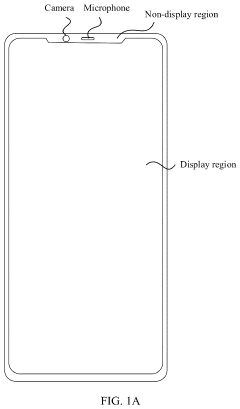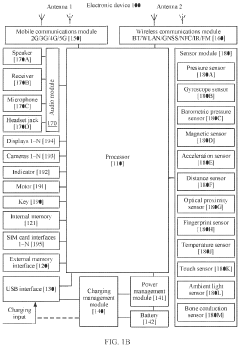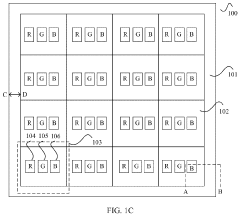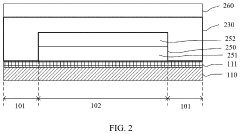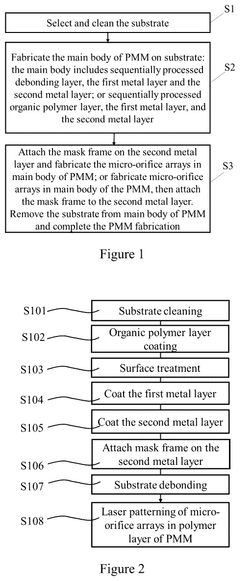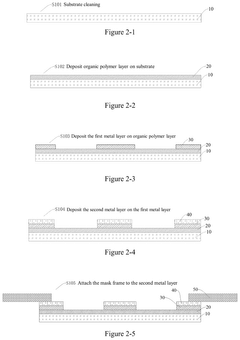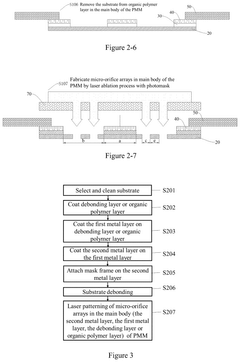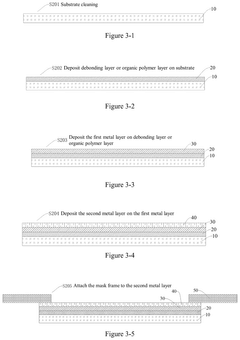AMOLED display integration in augmented reality glasses.
JUL 17, 20259 MIN READ
Generate Your Research Report Instantly with AI Agent
Patsnap Eureka helps you evaluate technical feasibility & market potential.
AR AMOLED Evolution
The evolution of AMOLED displays in augmented reality (AR) glasses represents a significant technological advancement in the field of wearable technology. This progression has been driven by the need for high-quality, energy-efficient displays that can deliver immersive AR experiences while maintaining a compact form factor.
In the early stages of AR glasses development, LCD displays were predominantly used due to their established manufacturing processes and lower costs. However, these displays had limitations in terms of contrast ratio, color reproduction, and power consumption, which hindered the overall AR experience.
The introduction of OLED technology marked a turning point in AR display evolution. OLED displays offered superior contrast ratios, wider color gamuts, and faster response times compared to LCDs. This improvement allowed for more vibrant and realistic AR overlays, enhancing the user experience significantly.
As OLED technology matured, AMOLED (Active-Matrix Organic Light-Emitting Diode) displays emerged as the preferred choice for AR glasses. AMOLED displays provided even better performance characteristics, including higher refresh rates, improved power efficiency, and the ability to produce true blacks by turning off individual pixels.
The integration of AMOLED displays in AR glasses has progressed through several key stages. Initially, the focus was on improving display resolution and pixel density to enhance the clarity of AR content. This was followed by efforts to increase the field of view (FOV) to provide a more immersive AR experience.
Recent advancements have centered on developing flexible and transparent AMOLED displays, which allow for more ergonomic and aesthetically pleasing AR glasses designs. These innovations have enabled the creation of sleeker, lighter, and more comfortable AR devices that can be worn for extended periods.
Another critical area of development has been the optimization of AMOLED displays for low power consumption, addressing one of the primary challenges in wearable AR technology. This has involved improvements in pixel architecture, driving circuits, and power management systems.
The latest iterations of AMOLED displays for AR glasses have also focused on enhancing outdoor visibility through increased brightness and improved anti-reflective coatings. This has expanded the usability of AR glasses in various lighting conditions, making them more practical for everyday use.
Looking ahead, the evolution of AMOLED displays in AR glasses is expected to continue with advancements in micro-LED technology, which promises even higher brightness, lower power consumption, and potentially higher pixel densities. Additionally, research into holographic and light field displays may lead to new breakthroughs in AR display technology, further enhancing the realism and immersion of augmented reality experiences.
In the early stages of AR glasses development, LCD displays were predominantly used due to their established manufacturing processes and lower costs. However, these displays had limitations in terms of contrast ratio, color reproduction, and power consumption, which hindered the overall AR experience.
The introduction of OLED technology marked a turning point in AR display evolution. OLED displays offered superior contrast ratios, wider color gamuts, and faster response times compared to LCDs. This improvement allowed for more vibrant and realistic AR overlays, enhancing the user experience significantly.
As OLED technology matured, AMOLED (Active-Matrix Organic Light-Emitting Diode) displays emerged as the preferred choice for AR glasses. AMOLED displays provided even better performance characteristics, including higher refresh rates, improved power efficiency, and the ability to produce true blacks by turning off individual pixels.
The integration of AMOLED displays in AR glasses has progressed through several key stages. Initially, the focus was on improving display resolution and pixel density to enhance the clarity of AR content. This was followed by efforts to increase the field of view (FOV) to provide a more immersive AR experience.
Recent advancements have centered on developing flexible and transparent AMOLED displays, which allow for more ergonomic and aesthetically pleasing AR glasses designs. These innovations have enabled the creation of sleeker, lighter, and more comfortable AR devices that can be worn for extended periods.
Another critical area of development has been the optimization of AMOLED displays for low power consumption, addressing one of the primary challenges in wearable AR technology. This has involved improvements in pixel architecture, driving circuits, and power management systems.
The latest iterations of AMOLED displays for AR glasses have also focused on enhancing outdoor visibility through increased brightness and improved anti-reflective coatings. This has expanded the usability of AR glasses in various lighting conditions, making them more practical for everyday use.
Looking ahead, the evolution of AMOLED displays in AR glasses is expected to continue with advancements in micro-LED technology, which promises even higher brightness, lower power consumption, and potentially higher pixel densities. Additionally, research into holographic and light field displays may lead to new breakthroughs in AR display technology, further enhancing the realism and immersion of augmented reality experiences.
AR Market Demand
The augmented reality (AR) market has been experiencing significant growth, driven by increasing demand for immersive technologies across various industries. The integration of AMOLED displays in AR glasses represents a crucial advancement in this field, addressing the need for high-quality visual experiences in compact, wearable devices.
Consumer interest in AR glasses has been steadily rising, with applications spanning entertainment, gaming, education, and professional use cases. The global AR market size was valued at $17.67 billion in 2020 and is projected to reach $97.76 billion by 2028, growing at a CAGR of 48.3% from 2021 to 2028. This robust growth trajectory underscores the increasing demand for AR technologies, including advanced display solutions like AMOLED.
In the consumer sector, AR glasses are gaining traction for applications such as navigation, social media interaction, and immersive gaming experiences. The ability of AMOLED displays to provide vibrant colors, high contrast ratios, and energy efficiency makes them particularly attractive for these use cases, where visual quality and battery life are paramount.
The enterprise market for AR glasses is also expanding rapidly, with industries such as manufacturing, healthcare, and logistics adopting these devices for training, remote assistance, and workflow optimization. The demand for high-resolution, low-latency displays in these professional environments further drives the need for AMOLED integration in AR glasses.
The healthcare sector, in particular, has shown significant interest in AR glasses with advanced display technologies. Surgeons and medical professionals are utilizing AR glasses for real-time data visualization during procedures, enhancing precision and patient outcomes. The clarity and color accuracy of AMOLED displays are crucial in these high-stakes applications.
Education and training sectors are also contributing to the growing demand for AR glasses with superior display quality. As remote and immersive learning experiences become more prevalent, the need for devices that can deliver clear, detailed visuals for extended periods is increasing.
Despite the promising market outlook, challenges remain in widespread adoption. Cost considerations, form factor limitations, and the need for improved battery life continue to influence consumer and enterprise purchasing decisions. However, ongoing advancements in AMOLED technology, including increased efficiency and reduced production costs, are expected to address these concerns and further stimulate market demand.
As the AR market continues to evolve, the integration of AMOLED displays in AR glasses is poised to play a pivotal role in shaping user experiences and expanding application possibilities. The demand for these advanced display solutions is expected to grow in tandem with the overall AR market, driven by technological improvements and increasing recognition of AR's potential across various industries.
Consumer interest in AR glasses has been steadily rising, with applications spanning entertainment, gaming, education, and professional use cases. The global AR market size was valued at $17.67 billion in 2020 and is projected to reach $97.76 billion by 2028, growing at a CAGR of 48.3% from 2021 to 2028. This robust growth trajectory underscores the increasing demand for AR technologies, including advanced display solutions like AMOLED.
In the consumer sector, AR glasses are gaining traction for applications such as navigation, social media interaction, and immersive gaming experiences. The ability of AMOLED displays to provide vibrant colors, high contrast ratios, and energy efficiency makes them particularly attractive for these use cases, where visual quality and battery life are paramount.
The enterprise market for AR glasses is also expanding rapidly, with industries such as manufacturing, healthcare, and logistics adopting these devices for training, remote assistance, and workflow optimization. The demand for high-resolution, low-latency displays in these professional environments further drives the need for AMOLED integration in AR glasses.
The healthcare sector, in particular, has shown significant interest in AR glasses with advanced display technologies. Surgeons and medical professionals are utilizing AR glasses for real-time data visualization during procedures, enhancing precision and patient outcomes. The clarity and color accuracy of AMOLED displays are crucial in these high-stakes applications.
Education and training sectors are also contributing to the growing demand for AR glasses with superior display quality. As remote and immersive learning experiences become more prevalent, the need for devices that can deliver clear, detailed visuals for extended periods is increasing.
Despite the promising market outlook, challenges remain in widespread adoption. Cost considerations, form factor limitations, and the need for improved battery life continue to influence consumer and enterprise purchasing decisions. However, ongoing advancements in AMOLED technology, including increased efficiency and reduced production costs, are expected to address these concerns and further stimulate market demand.
As the AR market continues to evolve, the integration of AMOLED displays in AR glasses is poised to play a pivotal role in shaping user experiences and expanding application possibilities. The demand for these advanced display solutions is expected to grow in tandem with the overall AR market, driven by technological improvements and increasing recognition of AR's potential across various industries.
AMOLED AR Challenges
The integration of AMOLED displays in augmented reality (AR) glasses presents several significant challenges that researchers and manufacturers must overcome. One of the primary obstacles is the miniaturization of AMOLED panels while maintaining high resolution and brightness. AR glasses require compact displays that can fit within the limited form factor of eyewear, yet still deliver crisp, clear images with sufficient luminance for outdoor use.
Power consumption is another critical challenge. AMOLED displays are known for their energy efficiency, but AR applications demand constant display operation, which can quickly drain battery life. Balancing power usage with performance is crucial for creating AR glasses that can be worn for extended periods without frequent recharging.
Heat dissipation poses a significant hurdle in AMOLED AR integration. The close proximity of the display to the user's face necessitates effective thermal management to ensure comfort and safety. Overheating can not only cause discomfort but also potentially damage the sensitive AMOLED panels or other components within the AR glasses.
Optical design presents complex challenges in incorporating AMOLED displays into AR glasses. Engineers must develop sophisticated lens systems that can effectively project the display image onto the user's field of view while maintaining proper focus and minimizing distortions. This often requires custom-designed optics that can work within the confined spaces of AR eyewear.
Durability and longevity of AMOLED displays in AR applications are also significant concerns. The displays must withstand the rigors of daily wear, including exposure to varying temperatures, humidity, and potential impacts. Preventing pixel degradation and burn-in, which are common issues with AMOLED technology, becomes even more critical in AR glasses where the display is in constant use.
Color accuracy and consistency across the display are vital for delivering a high-quality AR experience. AMOLED displays must be calibrated to provide true-to-life colors and maintain uniformity across the entire panel, which can be challenging given the curved surfaces often required in AR glasses designs.
Finally, manufacturing scalability remains a significant challenge. Producing AMOLED displays for AR glasses at scale requires highly specialized equipment and processes. Achieving high yields while maintaining quality and keeping costs manageable is essential for the widespread adoption of AMOLED-based AR glasses in the consumer market.
Power consumption is another critical challenge. AMOLED displays are known for their energy efficiency, but AR applications demand constant display operation, which can quickly drain battery life. Balancing power usage with performance is crucial for creating AR glasses that can be worn for extended periods without frequent recharging.
Heat dissipation poses a significant hurdle in AMOLED AR integration. The close proximity of the display to the user's face necessitates effective thermal management to ensure comfort and safety. Overheating can not only cause discomfort but also potentially damage the sensitive AMOLED panels or other components within the AR glasses.
Optical design presents complex challenges in incorporating AMOLED displays into AR glasses. Engineers must develop sophisticated lens systems that can effectively project the display image onto the user's field of view while maintaining proper focus and minimizing distortions. This often requires custom-designed optics that can work within the confined spaces of AR eyewear.
Durability and longevity of AMOLED displays in AR applications are also significant concerns. The displays must withstand the rigors of daily wear, including exposure to varying temperatures, humidity, and potential impacts. Preventing pixel degradation and burn-in, which are common issues with AMOLED technology, becomes even more critical in AR glasses where the display is in constant use.
Color accuracy and consistency across the display are vital for delivering a high-quality AR experience. AMOLED displays must be calibrated to provide true-to-life colors and maintain uniformity across the entire panel, which can be challenging given the curved surfaces often required in AR glasses designs.
Finally, manufacturing scalability remains a significant challenge. Producing AMOLED displays for AR glasses at scale requires highly specialized equipment and processes. Achieving high yields while maintaining quality and keeping costs manageable is essential for the widespread adoption of AMOLED-based AR glasses in the consumer market.
AMOLED AR Solutions
01 Integration of touch sensors with AMOLED displays
This approach involves integrating touch sensors directly into the AMOLED display structure. By combining the touch functionality with the display, it reduces the overall thickness of the device and improves optical performance. This integration can be achieved through various methods, such as in-cell or on-cell touch technologies, which embed the touch sensors within the display layers.- Integration of touch sensors with AMOLED displays: This approach involves integrating touch sensors directly into the AMOLED display structure. By incorporating touch functionality within the display layers, manufacturers can create thinner and more responsive devices. This integration can improve overall device performance and user experience while reducing the need for separate touch panels.
- Pixel circuit design for AMOLED displays: Advanced pixel circuit designs are crucial for improving AMOLED display performance. These circuits control the current flow to each pixel, ensuring accurate color reproduction and brightness levels. Innovations in pixel circuit design can lead to better power efficiency, reduced image retention, and improved overall display quality.
- AMOLED display driver integration: Integrating display drivers directly into the AMOLED panel can enhance performance and reduce the overall footprint of the display system. This approach can lead to improved power efficiency, faster response times, and better synchronization between the display and other device components.
- Flexible and foldable AMOLED displays: Developing flexible and foldable AMOLED displays involves integrating novel materials and structural designs. This technology enables the creation of bendable, rollable, or foldable devices, expanding the possibilities for innovative form factors in smartphones, tablets, and wearable devices.
- AMOLED display with integrated fingerprint sensors: Integrating fingerprint sensors directly into AMOLED displays allows for seamless biometric authentication without the need for separate hardware components. This technology can improve device security while maintaining a sleek and uninterrupted display surface, enhancing both functionality and aesthetics.
02 Pixel circuit design for AMOLED displays
Advanced pixel circuit designs are crucial for improving AMOLED display performance. These circuits control the current flow to each OLED pixel, ensuring uniform brightness and color accuracy. Innovations in this area focus on compensating for variations in transistor characteristics, reducing power consumption, and enhancing display quality.Expand Specific Solutions03 Flexible and foldable AMOLED displays
Developing flexible and foldable AMOLED displays involves creating display structures that can bend or fold without compromising functionality. This requires innovative materials and manufacturing processes to ensure durability and maintain display quality when flexed. Integration of touch functionality in these flexible displays presents additional challenges that need to be addressed.Expand Specific Solutions04 AMOLED display driver integration
Integrating display drivers with AMOLED panels is crucial for efficient operation. This involves designing compact driver ICs that can be directly mounted on the display substrate or closely integrated with the panel. Advanced driver designs focus on supporting high refresh rates, reducing power consumption, and enabling features like variable refresh rates.Expand Specific Solutions05 AMOLED display with integrated sensors
This approach involves integrating various sensors, such as fingerprint sensors or ambient light sensors, directly into the AMOLED display structure. By embedding these sensors within the display, it allows for a cleaner device design and potentially improved functionality. This integration requires careful consideration of the display stack and sensor placement to ensure optimal performance.Expand Specific Solutions
AR Display Competitors
The integration of AMOLED displays in augmented reality (AR) glasses represents a competitive and rapidly evolving technological landscape. The market is in its early growth stage, with significant potential for expansion as AR applications become more widespread. Key players like Samsung Electronics, BOE Technology, and Japan Display are leveraging their expertise in display technologies to gain a foothold in this emerging sector. Companies such as Google, Snap, and Magic Leap are driving innovation in AR hardware and software integration. The technology is advancing quickly, with improvements in display resolution, brightness, and power efficiency, but challenges remain in miniaturization and optical performance for seamless AR experiences. Collaborations between display manufacturers and AR specialists are accelerating progress, indicating a trend towards ecosystem development in this nascent market.
BOE Technology Group Co., Ltd.
Technical Solution: BOE has developed a comprehensive AMOLED solution for AR glasses, focusing on high pixel density and energy efficiency. Their technology features a 0.39-inch AMOLED microdisplay with a resolution of 1920x1080 pixels, resulting in an ultra-high pixel density of over 5,000 ppi [9]. BOE's AMOLED panels for AR incorporate a specialized OLED material stack optimized for near-eye applications, reducing eye strain during prolonged use. The company has implemented an advanced pixel circuit design that improves uniformity and reduces color shift at different viewing angles. BOE's integration includes a custom display driver that supports variable refresh rates (30-90 Hz) to balance performance and power consumption. Additionally, they have developed a novel encapsulation technique that enhances the durability and lifespan of the AMOLED displays in AR glasses, addressing concerns about long-term reliability [10].
Strengths: Ultra-high pixel density, optimized for eye comfort, advanced durability features. Weaknesses: Potential challenges in achieving high brightness levels, limited field of view compared to some competitors.
Samsung Electronics Co., Ltd.
Technical Solution: Samsung has developed advanced AMOLED displays specifically for AR glasses, featuring high resolution (over 2000 ppi) and brightness (up to 10,000 nits) [1]. Their technology incorporates a unique pixel structure that enhances light transmission and reduces power consumption. Samsung's AMOLED displays for AR utilize a custom OLED material stack optimized for near-eye applications, minimizing motion blur and improving color accuracy. The company has also implemented a novel driving scheme that allows for faster refresh rates (up to 120 Hz) while maintaining low latency, crucial for immersive AR experiences [2]. Additionally, Samsung has integrated advanced touch and force-sensing capabilities directly into the AMOLED panel, enabling intuitive user interactions within the AR interface.
Strengths: Industry-leading display quality, high brightness for outdoor use, low power consumption. Weaknesses: Potentially higher cost, complexity in mass production for AR-specific applications.
Key AMOLED AR Patents
Display, electronic device, and display fabrication method
PatentActiveUS12021070B2
Innovation
- The implementation of a display structure that includes a substrate, a driver circuit backplane, a first pixel layer with organic light-emitting diodes, and a second pixel layer with micro light-emitting diodes surrounding the first layer, where the micro LED layer is used to reduce the non-display region by replacing the traditional bezel function and isolating the OLED components from water and oxygen.
Production method to produce a precision micro-mask including attaching a mask frame to a metal layer by laser welding and an AMOLED display manufactured therefrom
PatentActiveUS12127468B2
Innovation
- A new Precision Micro-Mask (PMM) fabrication process involving a debonding layer, first and second metal layers, and laser welding to create micro-orifice arrays, allowing for the production of PMM used as a shadow mask in thermal evaporation for OLED device patterning, enabling ultrahigh resolution (>1000 PPI) full color AMOLED displays with RGB SBS architecture.
Optical Design for AR
The optical design for augmented reality (AR) glasses is a critical component in the integration of AMOLED displays. This design must address several key challenges to ensure optimal performance and user experience. One of the primary considerations is the field of view (FOV), which directly impacts the immersiveness of the AR experience. Current AR glasses typically offer a FOV ranging from 30 to 52 degrees, with ongoing research aimed at expanding this to 90 degrees or more.
Light efficiency is another crucial factor in optical design. AR glasses must efficiently guide light from the AMOLED display to the user's eyes while minimizing loss. This involves careful selection of materials and coatings for optical elements, as well as precise engineering of light paths. Waveguide technology has emerged as a popular solution, allowing for a compact form factor while maintaining good light transmission.
Color accuracy and contrast are essential for delivering high-quality visuals in AR glasses. AMOLED displays offer excellent color reproduction and contrast ratios, but the optical system must preserve these qualities. This requires careful calibration and color management throughout the optical path, including compensation for any distortions introduced by the lenses or waveguides.
Eye tracking integration is becoming increasingly important in AR optical design. By accurately tracking eye movements, the system can optimize rendering and focus, reducing computational load and improving visual comfort. This technology also enables foveated rendering, which concentrates high-resolution imagery where the user is looking, allowing for more efficient use of processing power.
Minimizing visual artifacts is a significant challenge in AR optical design. Issues such as ghosting, color fringing, and distortion can severely impact the user experience. Advanced optical designs incorporate corrective elements and sophisticated algorithms to mitigate these problems, ensuring a clear and seamless blend between the virtual and real worlds.
The form factor of AR glasses is a critical consideration, driving the need for compact and lightweight optical solutions. This has led to innovations in lens design, such as pancake optics and holographic optical elements, which can significantly reduce the overall size and weight of the device while maintaining optical performance.
As AMOLED display technology continues to advance, optical designs for AR glasses must evolve to fully leverage these improvements. This includes accommodating higher resolutions, faster refresh rates, and enhanced brightness levels. The integration of these displays with cutting-edge optical designs will be key to realizing the full potential of augmented reality technology in compact, wearable form factors.
Light efficiency is another crucial factor in optical design. AR glasses must efficiently guide light from the AMOLED display to the user's eyes while minimizing loss. This involves careful selection of materials and coatings for optical elements, as well as precise engineering of light paths. Waveguide technology has emerged as a popular solution, allowing for a compact form factor while maintaining good light transmission.
Color accuracy and contrast are essential for delivering high-quality visuals in AR glasses. AMOLED displays offer excellent color reproduction and contrast ratios, but the optical system must preserve these qualities. This requires careful calibration and color management throughout the optical path, including compensation for any distortions introduced by the lenses or waveguides.
Eye tracking integration is becoming increasingly important in AR optical design. By accurately tracking eye movements, the system can optimize rendering and focus, reducing computational load and improving visual comfort. This technology also enables foveated rendering, which concentrates high-resolution imagery where the user is looking, allowing for more efficient use of processing power.
Minimizing visual artifacts is a significant challenge in AR optical design. Issues such as ghosting, color fringing, and distortion can severely impact the user experience. Advanced optical designs incorporate corrective elements and sophisticated algorithms to mitigate these problems, ensuring a clear and seamless blend between the virtual and real worlds.
The form factor of AR glasses is a critical consideration, driving the need for compact and lightweight optical solutions. This has led to innovations in lens design, such as pancake optics and holographic optical elements, which can significantly reduce the overall size and weight of the device while maintaining optical performance.
As AMOLED display technology continues to advance, optical designs for AR glasses must evolve to fully leverage these improvements. This includes accommodating higher resolutions, faster refresh rates, and enhanced brightness levels. The integration of these displays with cutting-edge optical designs will be key to realizing the full potential of augmented reality technology in compact, wearable form factors.
Power Efficiency in AR
Power efficiency is a critical factor in the development and adoption of augmented reality (AR) glasses, particularly when integrating AMOLED displays. The energy consumption of AR devices significantly impacts their usability, battery life, and overall user experience. As AMOLED displays are known for their high contrast ratios and vibrant colors, their integration into AR glasses presents both opportunities and challenges in terms of power management.
One of the primary concerns in AR power efficiency is the display's energy consumption. AMOLED displays offer potential advantages in this area due to their ability to selectively illuminate individual pixels, potentially reducing power usage in darker scenes. However, the high brightness requirements for outdoor visibility in AR applications can offset these gains, necessitating careful optimization of display brightness and content.
Heat dissipation is another crucial aspect of power efficiency in AR glasses. The compact form factor of these devices limits the space available for cooling systems, making efficient power management essential to prevent overheating. AMOLED displays generate less heat compared to traditional LCD screens, which can contribute to improved thermal management in AR glasses.
Battery technology plays a vital role in the power efficiency of AR devices. The limited space available in AR glasses restricts battery size, emphasizing the need for high-density energy storage solutions. Advancements in battery technology, such as solid-state batteries or flexible batteries that can be integrated into the frame of the glasses, are being explored to address this challenge.
Power management systems in AR glasses must be sophisticated enough to balance performance with energy conservation. Dynamic power scaling, which adjusts the device's performance based on user activity and environmental conditions, is a key strategy for optimizing power efficiency. This approach involves intelligently managing the power consumption of various components, including the AMOLED display, processors, and sensors.
The integration of low-power processors and co-processors specifically designed for AR applications is another avenue for improving power efficiency. These specialized chips can handle tasks such as image processing, eye tracking, and gesture recognition more efficiently than general-purpose processors, reducing overall power consumption.
Optimizing software and algorithms for power efficiency is equally important. This includes developing rendering techniques that minimize the number of pixels that need to be illuminated on the AMOLED display, as well as implementing efficient data processing algorithms that reduce computational load and, consequently, power consumption.
One of the primary concerns in AR power efficiency is the display's energy consumption. AMOLED displays offer potential advantages in this area due to their ability to selectively illuminate individual pixels, potentially reducing power usage in darker scenes. However, the high brightness requirements for outdoor visibility in AR applications can offset these gains, necessitating careful optimization of display brightness and content.
Heat dissipation is another crucial aspect of power efficiency in AR glasses. The compact form factor of these devices limits the space available for cooling systems, making efficient power management essential to prevent overheating. AMOLED displays generate less heat compared to traditional LCD screens, which can contribute to improved thermal management in AR glasses.
Battery technology plays a vital role in the power efficiency of AR devices. The limited space available in AR glasses restricts battery size, emphasizing the need for high-density energy storage solutions. Advancements in battery technology, such as solid-state batteries or flexible batteries that can be integrated into the frame of the glasses, are being explored to address this challenge.
Power management systems in AR glasses must be sophisticated enough to balance performance with energy conservation. Dynamic power scaling, which adjusts the device's performance based on user activity and environmental conditions, is a key strategy for optimizing power efficiency. This approach involves intelligently managing the power consumption of various components, including the AMOLED display, processors, and sensors.
The integration of low-power processors and co-processors specifically designed for AR applications is another avenue for improving power efficiency. These specialized chips can handle tasks such as image processing, eye tracking, and gesture recognition more efficiently than general-purpose processors, reducing overall power consumption.
Optimizing software and algorithms for power efficiency is equally important. This includes developing rendering techniques that minimize the number of pixels that need to be illuminated on the AMOLED display, as well as implementing efficient data processing algorithms that reduce computational load and, consequently, power consumption.
Unlock deeper insights with Patsnap Eureka Quick Research — get a full tech report to explore trends and direct your research. Try now!
Generate Your Research Report Instantly with AI Agent
Supercharge your innovation with Patsnap Eureka AI Agent Platform!
